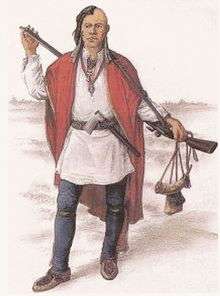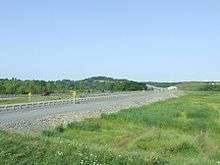Battle at St. Croix
| Battle at St. Croix | |||||||
|---|---|---|---|---|---|---|---|
| Part of Father Le Loutre’s War | |||||||
"Battle Hill", St. Croix, Nova Scotia | |||||||
| |||||||
| Belligerents | |||||||
| Mi'kmaq militia |
| ||||||
| Commanders and leaders | |||||||
| unknown |
John Gorham (wounded) Captain William Clapham Captain George St. Loe | ||||||
| Strength | |||||||
| unknown | unknown | ||||||
| Casualties and losses | |||||||
| unknown | three wounded, including Gorham | ||||||
| Military history of Mi’kmaq people | ||||||||||||||||||||||||||||||||||||||||||||||||||||||||||||||||
|---|---|---|---|---|---|---|---|---|---|---|---|---|---|---|---|---|---|---|---|---|---|---|---|---|---|---|---|---|---|---|---|---|---|---|---|---|---|---|---|---|---|---|---|---|---|---|---|---|---|---|---|---|---|---|---|---|---|---|---|---|---|---|---|---|
 Mi’kmaq Warrior | ||||||||||||||||||||||||||||||||||||||||||||||||||||||||||||||||
| Events | ||||||||||||||||||||||||||||||||||||||||||||||||||||||||||||||||
|
||||||||||||||||||||||||||||||||||||||||||||||||||||||||||||||||
| Other | ||||||||||||||||||||||||||||||||||||||||||||||||||||||||||||||||
|
| ||||||||||||||||||||||||||||||||||||||||||||||||||||||||||||||||
The Battle at St. Croix was fought during Father Le Loutre’s War between New England Rangers and Mi’kmaq at Battle Hill in the community of St. Croix, Nova Scotia. The battle lasted for three days in the spring of 1750, March 20–23.
Historical context
Despite the British Conquest of Acadia in 1710, Nova Scotia remained primarily occupied by Catholic Acadians and Mi'kmaq. By the time Cornwallis had arrived in Halifax, there was a long history of the Wabanaki Confederacy (which included the Mi'kmaq) protecting their land by killing British civilians along the New England/ Acadia border in Maine (See the Northeast Coast Campaigns 1688, 1703, 1723, 1724, 1745, 1746, 1747).[1]
To prevent the establishment of Protestant settlements in the region, Mi'kmaq raided the early British settlements of present-day Shelburne (1715) and Canso (1720). A generation later, Father Le Loutre's War began when Edward Cornwallis arrived to establish Halifax with 13 transports on June 21, 1749.[2] By unilaterally establishing Halifax the British were violating earlier treaties with the Mi'kmaq (1726), which were signed after Father Rale's War.[3]
Within 18 months of establishing Halifax, the British also took firm control of peninsula Nova Scotia by building fortifications in all the major Acadian communities: present-day Windsor (Fort Edward); Grand Pre (Fort Vieux Logis) and Chignecto (Fort Lawrence). (A British fort already existed at the other major Acadian centre of Annapolis Royal, Nova Scotia. Cobequid remained without a fort.)[4] There were numerous Mi'kmaq and Acadian raids on these fortifications.
Prior to the Battle, on September 30, 1749, about forty Mi'kmaq attacked six men who were cutting trees at a saw mill in Dartmouth, Nova Scotia. Four of them were killed on the spot, one was taken prisoner and one escaped.[5] Two of the men were scalped and the heads of the others were cut off. A detachment of rangers was sent after the raiding party and cut off the heads of two Mi'kmaq and scalped one.[6]
In response to the raid in Dartmouth, on October 2, 1749, Cornwallis offered a bounty on the head of every Mi'kmaq. He set the amount at the same rate that the Mi'kmaq received from the French for British scalps.[7] As well, to carry out this task, two companies of rangers were raised, one led by Captain Francis Bartelo and the other by Captain William Clapham. These two companies served alongside that of John Gorham's company. The three companies scoured the land around looking for Mi'kmaq.[7] 'After the destruction of Mirligueche (later known as Lunenburg, Nova Scotia), the Siege of Grand Pre was the first recorded conflict after Cornwallis’ bounty proclamation. The Battle at St. Croix happened while New England Rangers were en route to Grand Pre to arrest the Acadians who had supported the siege.
Battle

Upon recently building a road from Halifax to Grand Pre, on December 17, Cornwallis ordered Gorham to clear the road of natives who might hinder communications.[8] According to British accounts of the battle, on March 18, 1750 a group of Rangers under the command of John Gorham (military officer) left Fort Sackville (at present day Bedford, Nova Scotia), under orders from Governor Cornwallis to march to Piziquid (Windsor).[9] Their mission was to establish a blockhouse at Piziquid (i.e., Fort Edward), and to seize the property of Acadians who had participated in the Siege of Grand Pre.
Arriving at about noon on March 20 at the Acadian village of Five Houses beside the St. Croix River, Gorham and his men found all the houses deserted. Seeing a group of Mi’kmaq hiding in the bushes on the opposite shore, the Rangers opened fire. The skirmish deteriorated into a siege, with Gorham’s men taking refuge in a sawmill and two of the houses. During the fighting around "Battle Hill", the Rangers suffered three wounded including Gorham, who sustained a bullet in the thigh. As the fighting intensified, a request was sent back to Fort Sackville for reinforcements.[10]
Responding to the call for assistance on March 22, Governor Cornwallis ordered Captain Clapham’s and Captain George St. Loe of the 40th Regiment of Foot, equipped with two field guns, to join Gorham at Piziquid. The additional troops and artillery turned the tide for Gorham, and forced the Mi’kmaq to withdraw.[11]
Aftermath

After the siege, Gorham and the additional troops continued on to Piziquid. Arriving there, Gorham established himself at the Parish Church of L’Assomption (the present site of Fort Edward) and proceeded to scour the surrounding countryside in a search-and-destroy mission against the Mi’kmaq.[11] Richard Bulkeley wrote that between 1749 and 1755, Nova Scotia "was kept in an uninterrupted state of war by the Acadians... and the reports of an officer commanding Fort Edward (Nova Scotia), [indicated he] could not be conveyed [to Halifax] with less an escort than an officer and thirty men."[12] In March 1750, the Mi'kmaq and Acadian militias killed Cornwallis' messenger who was en route from Halifax to Chignecto.[13] Cornwallis stopped sending small parties out of Halifax.[14]
References
- ↑ John Reid.“Amerindian Power in the Early Modern Northeast: A Reappraisal.” in Essays on Northeastern North America: Seventeenth and Eighteenth Centuries (Toronto: University of Toronto Press, 2008) ; Grenier, John. The Far Reaches of Empire. War in Nova Scotia, 1710–1760. University of Oklahoma Press, Norman, 2008.
- ↑ Grenier, John. The Far Reaches of Empire. War in Nova Scotia, 1710–1760. Norman: U of Oklahoma P, 2008; Thomas Beamish Akins. History of Halifax, Brookhouse Press. 1895. (2002 edition). p 7
- ↑ Wicken, p. 181; Griffith, p. 390; Also see "Archived copy". Archived from the original on 2013-05-14. Retrieved 2014-02-05.
- ↑ John Grenier. The Far Reaches of Empire: War in Nova Scotia, 1710–1760. Oklahoma University Press.
- ↑ Harry Chapman. In the Wake of the Alderney: Dartmouth, Nova Scotia, 1750–2000. Dartmouth Historical Association. 2000. p. 23.
- ↑ Thomas Beamish Akins. History of Halifax, Brookhouse Press. 1895. (2002 edition). p 18.
- 1 2 Thomas Beamish Akins. History of Halifax, Brookhouse Press. 1895. (2002 edition). p 19.
- ↑ Beamish Murdoch. A History of Nova Scotia. Vol. 2. p.166
- ↑ As with many battles with natives during the colonial period, the only written account of this battle is by the British.
- ↑ Grenier pp. 154–155.
- 1 2 Murdoch p. 174.
- ↑ "Collections of the Nova Scotia Historical Society, p. 152". archive.org. Retrieved 1 November 2015.
- ↑ "Selections from the public documents of the province of Nova Scotia". archive.org. Retrieved 1 November 2015.
- ↑ "Selections from the public documents of the province of Nova Scotia". archive.org. Retrieved 1 November 2015.
Literature cited
- Faragher, John. Great and Noble Scheme. New York: Norton, 2005.
- Grenier, John. The Far Reaches of Empire. War in Nova Scotia, 1710–1760. Norman: U of Oklahoma P, 2008. pp. 154–155
- Griffiths, Naomi Elizabeth Saundaus. From Migrant to Acadian: A North American border people, 1604–1755. Montreal, Kingston: McGill-Queen's UP, 2005.
- Landry, Peter. The Lion & The Lily. Vol. 1. Victoria: Trafford, 2007.
- Murdoch, Beamish. A History of Nova Scotia, Or Acadia. Vol 2. pp. 174–75
- Rompkey, Ronald, ed. Expeditions of Honour: The Journal of John Salusbury in Halifax, Nova Scotia, 1749–53. Newark: U of Delaware P, Newark, 1982.
External links
Coordinates: 44°57′42.9″N 64°2′1.6″W / 44.961917°N 64.033778°W